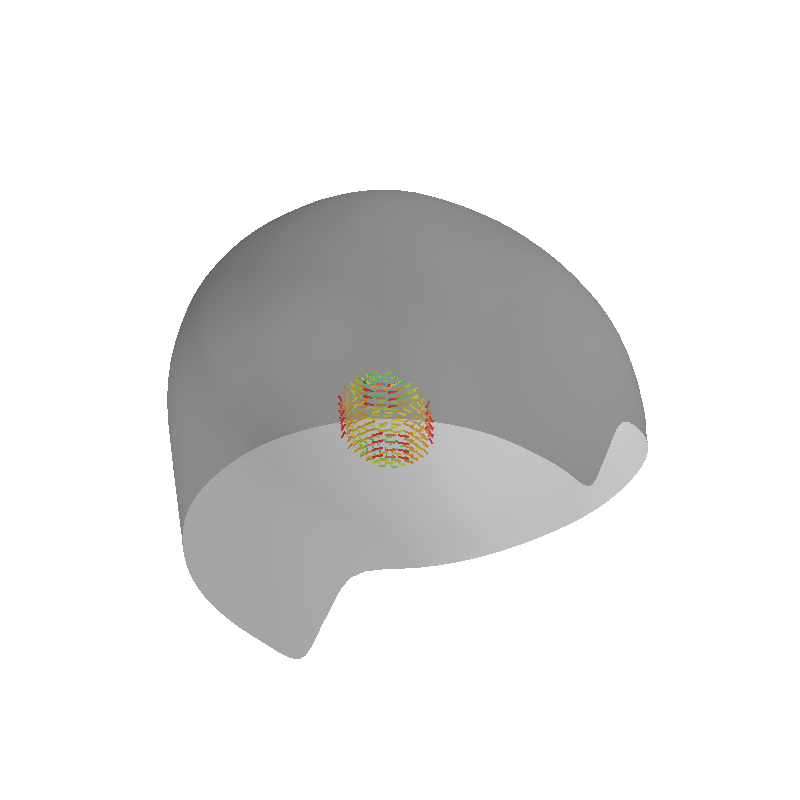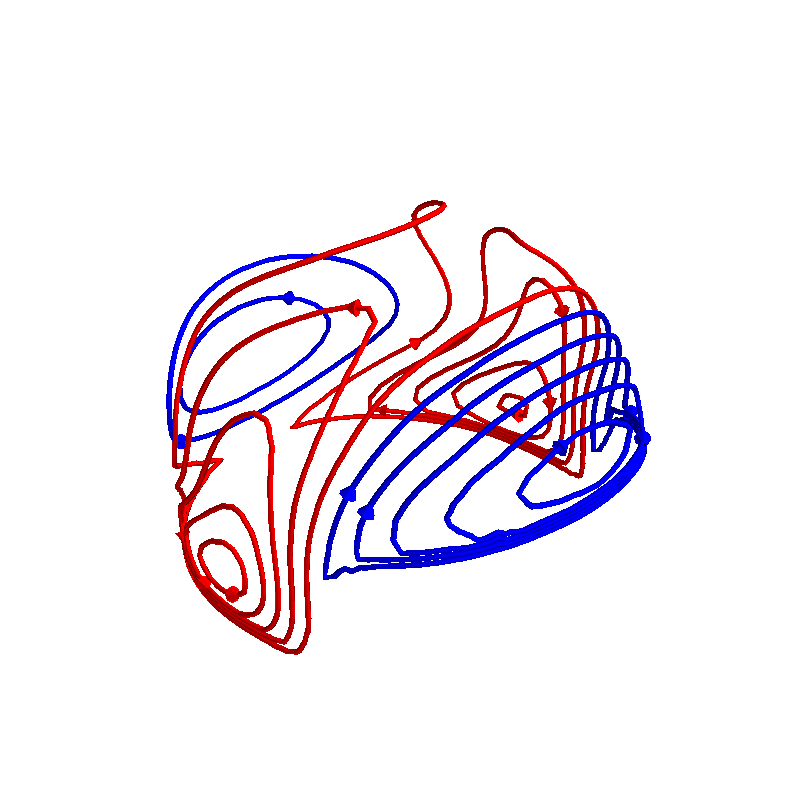Note
Click here to download the full example code
Head gradient coil¶
Example showing a gradient coil designed on the surface of a MEG system helmet
import numpy as np
from mayavi import mlab
from bfieldtools.mesh_conductor import MeshConductor
from bfieldtools.coil_optimize import optimize_streamfunctions
from bfieldtools.utils import load_example_mesh
from bfieldtools import sphtools
# Load simple plane mesh that is centered on the origin
helmetmesh = load_example_mesh("meg_helmet")
coil = MeshConductor(mesh_obj=helmetmesh, fix_normals=True)
Set up target and stray field points. Here, the target points are on a volumetric grid within a sphere
offset = np.array([0, 0, 0.04])
center = offset
sidelength = 0.05
n = 12
xx = np.linspace(-sidelength / 2, sidelength / 2, n)
yy = np.linspace(-sidelength / 2, sidelength / 2, n)
zz = np.linspace(-sidelength / 2, sidelength / 2, n)
X, Y, Z = np.meshgrid(xx, yy, zz, indexing="ij")
x = X.ravel()
y = Y.ravel()
z = Z.ravel()
target_points = np.array([x, y, z]).T
# Turn cube into sphere by rejecting points "in the corners"
# and inner points
target_points = (
target_points[
(np.linalg.norm(target_points, axis=1) < sidelength / 2)
* (np.linalg.norm(target_points, axis=1) > sidelength / 2 * 0.8)
]
+ center
)
Specify target field and run solver. Here, we specify the target field through the use of spherical harmonics. We want to produce the field corresponding to a specific beta_l,m-component.
lmax = 3
alm = np.zeros((lmax * (lmax + 2),))
blm = np.zeros((lmax * (lmax + 2),))
# Set one specific component to one
blm[3] += 1
sphfield = sphtools.field(target_points, alm, blm, lmax)
target_field = sphfield / np.max(sphfield[:, 0])
target_field[:, 2] = 0
coil.plot_mesh(opacity=0.5)
mlab.quiver3d(*target_points.T, *sphfield.T)
mlab.gcf().scene.isometric_view()
abs_error = np.zeros_like(target_field)
abs_error[:, 0] += 0.05
abs_error[:, 1:3] += 0.1
target_spec = {
"coupling": coil.B_coupling(target_points),
"abs_error": abs_error,
"target": target_field,
}

Out:
Computing magnetic field coupling matrix, 2044 vertices by 312 target points... took 0.24 seconds.
import mosek
coil.s, prob = optimize_streamfunctions(
coil,
[target_spec],
objective="minimum_inductive_energy",
solver="MOSEK",
solver_opts={"mosek_params": {mosek.iparam.num_threads: 8}},
)
Out:
Computing the inductance matrix...
Computing self-inductance matrix using rough quadrature (degree=2). For higher accuracy, set quad_degree to 4 or more.
Estimating 16313 MiB required for 2044 by 2044 vertices...
Computing inductance matrix in 40 chunks (9384 MiB memory free), when approx_far=True using more chunks is faster...
Computing triangle-coupling matrix
Inductance matrix computation took 7.43 seconds.
Pre-existing problem not passed, creating...
Passing parameters to problem...
Passing problem to solver...
Problem
Name :
Objective sense : min
Type : CONIC (conic optimization problem)
Constraints : 3819
Cones : 1
Scalar variables : 3893
Matrix variables : 0
Integer variables : 0
Optimizer started.
Problem
Name :
Objective sense : min
Type : CONIC (conic optimization problem)
Constraints : 3819
Cones : 1
Scalar variables : 3893
Matrix variables : 0
Integer variables : 0
Optimizer - threads : 8
Optimizer - solved problem : the dual
Optimizer - Constraints : 1946
Optimizer - Cones : 1
Optimizer - Scalar variables : 3819 conic : 1947
Optimizer - Semi-definite variables: 0 scalarized : 0
Factor - setup time : 0.28 dense det. time : 0.00
Factor - ML order time : 0.07 GP order time : 0.00
Factor - nonzeros before factor : 1.89e+06 after factor : 1.89e+06
Factor - dense dim. : 0 flops : 8.46e+09
ITE PFEAS DFEAS GFEAS PRSTATUS POBJ DOBJ MU TIME
0 5.6e+02 1.0e+00 2.0e+00 0.00e+00 0.000000000e+00 -1.000000000e+00 1.0e+00 1.40
1 2.4e+02 4.2e-01 1.2e+00 -9.49e-01 6.650619835e+00 6.946913020e+00 4.2e-01 1.63
2 7.7e+01 1.4e-01 6.3e-01 -8.61e-01 6.505864740e+01 6.862857116e+01 1.4e-01 1.82
3 2.3e+01 4.0e-02 2.4e-01 -6.12e-01 2.768754633e+02 2.845399199e+02 4.0e-02 2.02
4 3.1e+00 5.5e-03 2.6e-02 -9.44e-02 6.459947892e+02 6.513630397e+02 5.5e-03 2.22
5 5.7e-01 1.0e-03 2.2e-03 7.38e-01 5.178338127e+02 5.190086016e+02 1.0e-03 2.42
6 2.8e-01 5.0e-04 7.7e-04 9.52e-01 4.445760451e+02 4.451278532e+02 5.0e-04 2.63
7 5.1e-02 9.0e-05 5.1e-05 9.77e-01 3.974604461e+02 3.975340486e+02 9.0e-05 2.88
8 7.3e-03 1.3e-05 2.7e-06 9.95e-01 3.936012105e+02 3.936113968e+02 1.3e-05 3.15
9 1.0e-03 1.8e-06 1.4e-07 9.99e-01 3.928011290e+02 3.928024812e+02 1.8e-06 3.40
10 1.3e-04 2.4e-07 7.1e-09 1.00e+00 3.927465956e+02 3.927467997e+02 2.4e-07 3.60
11 2.6e-05 4.6e-08 5.9e-10 1.00e+00 3.927424767e+02 3.927425160e+02 4.6e-08 3.81
12 3.0e-06 5.3e-09 2.2e-11 1.00e+00 3.927425347e+02 3.927425392e+02 5.3e-09 4.02
13 4.3e-07 7.6e-10 1.2e-12 1.00e+00 3.927425447e+02 3.927425454e+02 7.6e-10 4.23
14 1.7e-07 1.1e-10 2.2e-13 1.00e+00 3.927425461e+02 3.927425438e+02 9.7e-15 4.46
Optimizer terminated. Time: 4.56
Interior-point solution summary
Problem status : PRIMAL_AND_DUAL_FEASIBLE
Solution status : OPTIMAL
Primal. obj: 3.9274254609e+02 nrm: 8e+02 Viol. con: 3e-13 var: 0e+00 cones: 0e+00
Dual. obj: 3.9274254381e+02 nrm: 2e+03 Viol. con: 3e-10 var: 7e-09 cones: 1e-13
Plot coil windings
loops = coil.s.discretize(N_contours=10)
loops.plot_loops()

Out:
<mayavi.core.scene.Scene object at 0x7f0c11d5cbf0>
Total running time of the script: ( 0 minutes 18.982 seconds)
Estimated memory usage: 1063 MB
